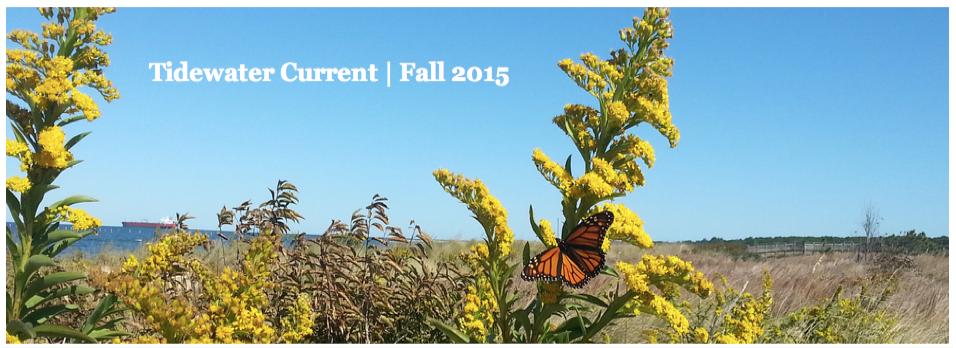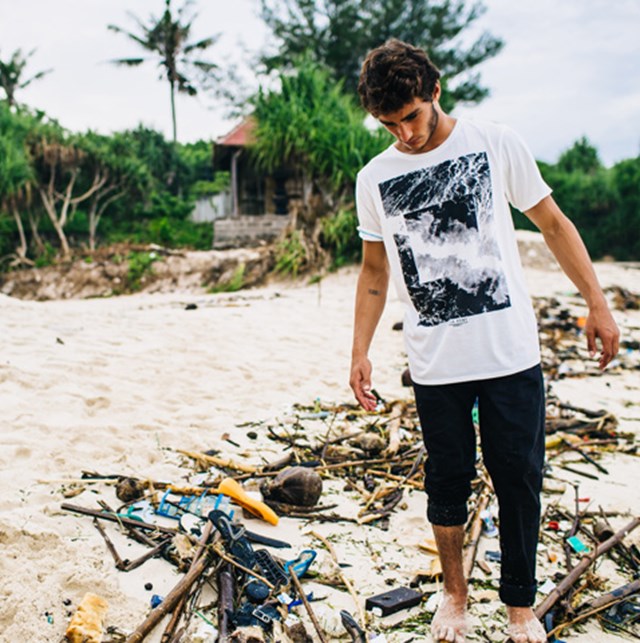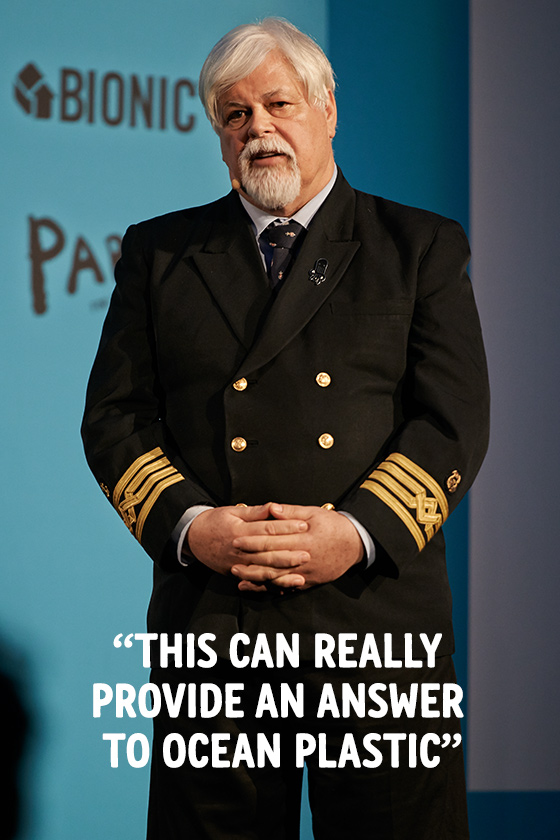
Transmitting news and information about sustainable endeavors in Coastal Virginia and beyond. Updated Weekly.
|
Fashion Sends an SOS for the Ocean
With Apparel fabricated from Plastic Debris Recovered from the Sea
Posted 10.24.15 by Carol Brighton | Music by Louis Smith (click to play, if plug-in does not start automatically)
With a lifestyle closely connected to the ocean, the surf community is acutely aware of the plasticized seascape. O'Neill, a leading outfitter for the industry, is making more than a fashion statement with a new line of surf wear to be debuted next year. The collection manufactured with plastic that washed ashore represents an endeavor to rid the ocean of the deadly invader. In a company video release, professional surfer Tai "Buddha" Graham, explains: "Growing up and travelling all around the world surfing, there's always been an issue with the rubbish. You're Paddling though junk and trash and its gross. ... We all need to stand up and do something about it."
Plastic is nondegradable and hazardous. When ingested by or entangling marine life, it is often lethal. It also releases toxic chemicals that move up the food chain ultimately threatening human health. And there are indications that this is already occurring. Synthetic fibers were found in 63% of shrimp sampled in the North Sea. The material is not only pervasive, it is ubiquitous. It is found far from human habitation scattered on remote island beaches and amassed in huge patches in the middle of every ocean. It's also prevalent close to home. Trawl surveys conducted by Trash Free Maryland recorded high concentrations of particulates in the Chesapeake Bay. Stiv Wilson, who participated in the fall 2014/2015 expeditions notes that plastic concentration in the Bay were as dense as he's seen on any expedition which includes visits to 4 out of the 5 ocean gyres.
|
Pharrell Williams Creates a Ripple Effect
Preventing the stream of plastics flowing to the sea is the obvious and best course of action. This could be achieved by developing a circular economy, where products are designed for endless reuse. Whether that's an achievable dream remains to be seen. Meanwhile, there's a staggering quantity of plastic already in the ocean. Over 5 trillion particles according to a recent calculation weighing some 270,000 metric tons. Researchers from the University of Georgia conservatively estimate that almost 9 million tons of plastic are added annually to the global ocean. On a per pound basis, that's comparable to the amount of tuna being taken out. Other calculations are much higher. Even if the surge to the sea ceases, there will still be tons of trash floating around for years and years to come. To put a dent in this accumulating debris and inspire others to also act, last year Bionic Yarn and Parley for the Oceans organized a star studded event in NYC. There, Bionic Yarn's creative director, pop icon Pharrell Williams, promoted the release of the new G-Star RAW denim collection created with ocean litter. G-Star Raw reports that approximately 700,000 PET plastic bottles have been recycled each season. Now Parley for the Oceans and Bionic Yarn have partnered with surf giant O'Neill. Through these collaborations, the recovery of waste washed ashore exemplifies a new resource stream that not only reduces pollution but also displaces the need for additional raw materials: Literally turning trash into treasure.
The issue hits close to home for Pharrell Williams. Growing up along the coast in Virginia Beach, the grammy award winning entertainer developed an affinity for the ocean. Pharrell even credits the ocean, in part, for his success. As he notes in the video documentary, Plastic Age, through the motion of the waves he discovered his love of music. Compelled to be part of the solution, he's using his star power to put the ocean plague on the world stage. His message: Recycled fashion represents an opportunity for everyone to participate in a pollution solution. It also serves as a physical reminder and catalyst for action. As Pharrell puts it, "wear the responsibility for the oceans." In connection with the G-Star RAW line, Pharrell is promoting a free downloadable game. It takes players on a nautical journey to collect ocean plastic and provides information on how it is recycled and made into garments. Battle For Big Blue is available on Google Play and the AppStore.
|
Support & Concern for Recycled Fabrics
In general, the conservation community has been behind efforts to transform plastic waste into a resource. Concern, however has been voiced about the use of plastics in textiles. Polyester, nylon and acrylic fibers were the dominate microplastics found in beach sediments at several locations around the world. Dr. Mark Browne, who conducted international surveys, discovered that these minute synthetic fibers likely represent the largest single type of of plastic debris in the sea. The surprising source of these fibers appears to be washing machines. The sheer volume of debris emitted from one load of laundry can consist of hundreds of thousands of microscopic strands. The inherently insidious soupy slush then infiltrates the food web. Textiles with recycled content may also release fibers in the wash.
Given the the fabrication process developed by Bionic Yarn which encapsulates plastic fibers, the material appears to be a durable. Learn more here. Still with wear and tear, fiber release could occur over time. If installed, washing machine filters could capture most of these fibers. More research is currently being conducted on the particular type of fabrics responsible for releasing prolific amounts of the microfibers and what can be done to limit it. It is also important to have an end of life option for garments containing plastics. Ideally, corporate take back programs will incentivize recycling or repurposing instead of landfilling.
In addition to using ocean plastic to create fabric, entrepreneurs are producing carpet, shoes, skateboard decks and art. Numerous opportunities exist to make plastics that biodegrade from natural sources. Food waste, seaweed, crab shell and more are being investigated. Imagine a surf board core blown from algae instead of fossil fuels. UC San Diego has manufactured and demonstrated a prototype. Reusable products and plastic substitutes are also driving innovation. Beverages could soon be served in cups embedded with seeds and straws, well, made from straw. Along with compostable products, edible utensils are being introduced into the market place. Soon consumers can enjoy their coffee and eat the cup too. Or, instead of hydrating from a disposable water bottle, it will be possible instead to pop an edible orb of water. Check out the flipboard collection Plastic Attack to read more about these innovations.
There's no reason to sacrifice the health of our ocean and thereby the fate of our species by continuing to forge a foolish path. We have the tools and technology to put the Plastic Age in the past and progress into a new era.
UPDATE: 3.11.2016 - BIONIC YARN recentlyt received Cradle to Cradle certification for the first apparel yarn containing recycled plastics. Another Virginia visionary, William McDonough, was involved in developing C2C certification. He's featured in the Winter 2016 edition of Tidewater Current.
Learn more:
The first Massive Open Online Course on Marine Litter starts this Monday, October 26th!
Previous Tidewater Current posts spotlighting pollution and/or the marine environment:
Getting Butts off the Beach | Gulf Oil Spill Implicated in Dolphin Die-Off | Fragile Mid-Atlantic Coral Habitat Protected
Nature at Work: Building Ecological Infrastructure | The Stars Come Out for the Ocean | Celebrating the Sea & Talking Trash
Waste as a Resource | Avoiding a Collision Course among Ocean Giants
The Plastic Age: A Documentary feat. Pharrell Williams (Full Film)
|
Music: Louis Smith - Sweet and Clean Youtube
Check the Archive for Previous Posts
All Rights Reserved. Disclaimer.
 Marine debris in Hawaii. In Virginia last year, a 45 ft. sei whale succumbed to injuries suffered after ingesting a plastic CD case shard. Recently a plastic bag was blamed for the demise of a melon-headed whale in
Marine debris in Hawaii. In Virginia last year, a 45 ft. sei whale succumbed to injuries suffered after ingesting a plastic CD case shard. Recently a plastic bag was blamed for the demise of a melon-headed whale in  Eco-threads from O'Neill designed with plastic debris from the sea. Bionic Yarn is the company supplying the recycled fabric for the surf wear. Pharrell Williams, the creative designer for Bionic Yarn wants you to "wear your responsibility" and raise awareness for the cause. Image:
Eco-threads from O'Neill designed with plastic debris from the sea. Bionic Yarn is the company supplying the recycled fabric for the surf wear. Pharrell Williams, the creative designer for Bionic Yarn wants you to "wear your responsibility" and raise awareness for the cause. Image: 